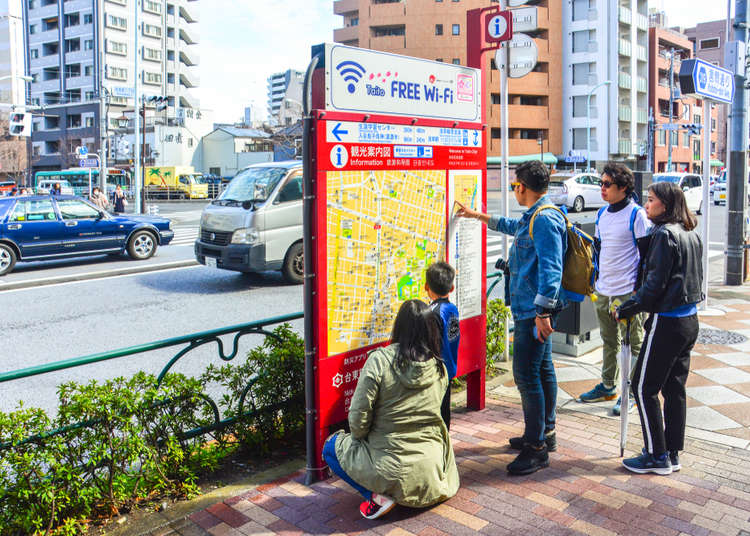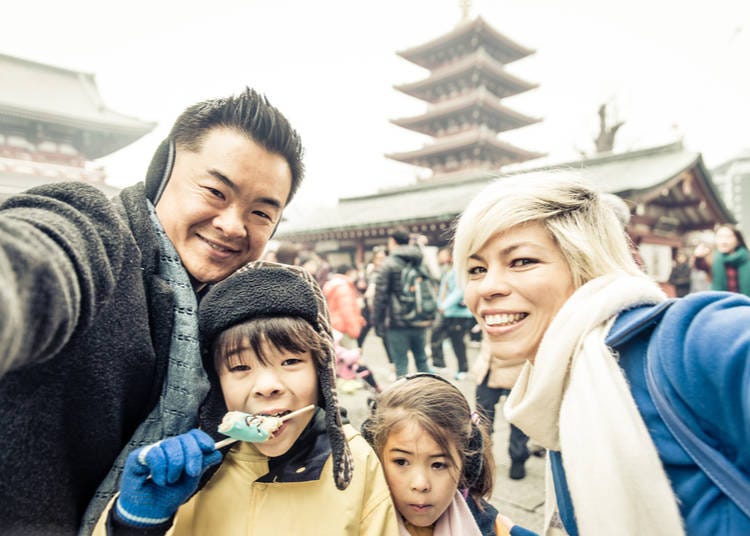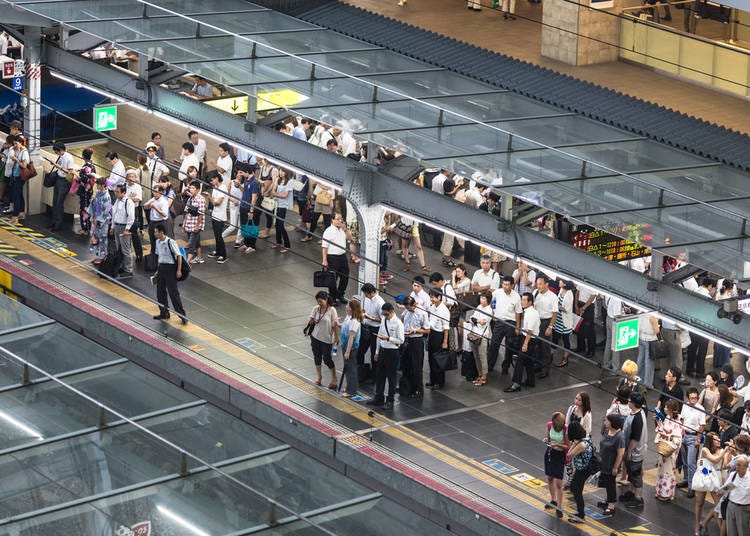
Japan is one of the world's most populous nations, with a host of frenetic metropolitan areas; buzzing nightlife, packed train stations, chock-a-block walkways and round-the-clock hustle and bustle.
While the fast-paced lifestyle and variety of lively entertainment make Japanese cities such attractive destinations, it means that sometimes – just occasionally – you may find yourself lost. Here are some pro tips on how to avoid getting lost in Japan, and how you can easily relocate your travel companions should it happen.
Prevention: Before You Get Lost

You can start by taking preventative measures towards getting lost before it happens with these 10 handy tips:
1. Plan Ahead
Make sure you know your accommodation information, have done a little research on the areas you'll be visiting, downloaded any of the necessary smartphone apps, and saved a few of those key Japanese phrases. Planning is key, and you'll be glad of it in the case of any mishaps!
2. Know Your Route
When you're out and about for the day, make a list of what you are going to see (when applicable) and consult a map to see how your route shapes up. If you get lost along a route that the whole party are adhering to, you should be able to relocate your companions pretty quickly.
3. Have Your Accommodation Written Down in Japanese
Having your accommodation written in Japanese can be particularly helpful if you're asking for directions on the street. This doesn't necessarily have to involve taking out a pen and laying siege to a piece of paper with incorrectly scribed kanji. A simple screenshot of the hotel name on your phone will suffice.
4. Use Portable WiFi
Portable WiFi is an incredibly utilitarian tool for the traveller in Japan. As the name infers, it's a portable WiFi receptor that you can bring with you for mobile data on the move. They are generally cheaper than most cell phone data plans, work in 95-99% of the country (quite something when you consider how many vast expanses of wilderness exist in Japan), can be used by 4-6 people, and have a battery life of 8-9 hours. BUT! Keep in mind, if you get separated from whoever is carrying the portable WiFi device, you won't be able to use it!
5. Charge Your Devices
Having a healthy amount of battery in your cell phone, portable WiFi (see above) and power bricks, is essential if you're out for the day. Consider investing in the latter of these. The Japanese are no stranger to portable charging devices, so following suit might not be a bad idea.
6. Have Some Key Japanese Phrases Handy
Phrase 1:
Where is _____? = _____ wa doko desu ka? (XXXはどこですか?)
Phrase 2:
Is there someone who can speak English? = Eigo hanaseru hito ga imasu ka? (英語話せる人がいますか?)
Phrase 3:
Is there WiFi here? = WiFi (pronounced why-fy) arimasu ka? (WiFiありますか?)
7. Wear Unique or Identifiable Clothing
This is not to suggest you should adorn yourself in anything overtly outlandish or garish. But maybe wearing a bright-colored hat or one that's brandished with a specific logo, or even a bag that is easily identifiable could help your fellow travellers locate you.
8. Set a Meeting Point
Most major areas and their accompanying train stations are kitted out with maps. Before you start exploring, agree on a specific location or point of interest at which you'll meet if the group gets separated. Tall buildings and monumental landmarks are easy to spot by simply looking up; however, they are more likely to be swarming with people at street level.
9. Set a Meeting Time if You Intend to Split Up
If you "get lost intentionally", set up a meeting time at the agreed upon location. This may sound obvious, but remember Tokyo is big, as are the composite neighborhoods that make up the city. Be sure to give yourself ample time to get back to your meeting point (and a little more time to locate your group once you get there).
10. Map Applications: Location Sharing
Most map applications (and some messenger apps) now have location sharing functionalities. If you're really in a pickle, have no idea where you are or where to go, then this can be your virtual "get out of jail free card". Once your location is shared, the respective recipients will have your location clearly indicated on their own smartphone maps.
Japan-Specific Tips and Hints for Staying Together

1. In Japan: Travelling with Kids
A) Who can kids trust to ask for directions, and how can they tell?
The vast majority of locals are super polite and equally accommodating. However, in the unfortunate event that your child does get lost, there are certain people they should look to for help. Police boxes ("koban") are located outside many major train stations – these are easily identifiable – and inside train stations there are information desks, and attendants usually attired in a suit with a policeman-like hat. These should be go-to spots for lost children.
B) Ensure kids have identification (bonus: in Japanese)
Japanese law states that tourists must carry their passports on them at all times. Though understandably, you may not want your child keeping hold of their own passport, especially if he/she has a penchant for losing things. But a photocopied version (with a Japanese katakana translation written on it), could prove vital in helping you relocate one of your strayed offspring!
C) Have kids carry hotel and contact information in English and Japanese
This one's pretty simple. Your hotel should have no qualms in supplying you (and every member in your party) with their address and other pertinent information on request at the reception desk.
D) Role-play the scene quickly to build confidence
This can be done at your own discretion, and maybe it's more important for the kids that like to wander. But a quick acting out of the "getting lost" scenario, might make the real deal a little easier for all parties involved.

2. In Japan: Train Stations
Some Japanese train stations are truly humongous, with cavernous networks of busy underground walkways. Getting lost in them is a real possibility, and finding people inside them isn’t always easy.
A) Rallying Points
For rallying points, exits are your best option. But beware, major stations can have more than 10 exits that are significantly spread out from one another. Pick a specific exit: Central, West, North, C7, B4, etc. The exit monikers will vary from station to station so some pre-planning may be necessary.
B) Tourist Information Centers and Police Koban
The aforementioned koban and train station information centers and helpdesks are easy to identify and typically staffed by English speakers.
3. In Japan: On the Train
Everyone has seen the videos of Tokyo's absurdly packed trains; it's just the reality of commuting in the world's most populous city. Getting lost on trains is indeed possible – believe it or not – especially if you're in a rush to squeeze through the carriage doors before the train departs. Once again, planning ahead here is key.
A) Crowded Train Times
Rush hour trains (7:00-9:30am and 5:00-7:00pm on weekdays) and last trains (usually around midnight) in Tokyo are almost a cert to be busy. If possible, avoiding the train during these times is a highly recommended.
B) Separated on the Train
Let's say part of your group gets on the train just before it departs and you don't. Or maybe part of your group gets off a stop too early. What do you do? Again, this is something you can mitigate against beforehand by agreeing a meeting point: i.e. destination + specific exit.
Alternatively, you can transfer to a train coming back from the direction you just came, to meet your party where you lost them. The same train lines going in opposite directions are usually located at platforms right beside each other in each station.
C) Use Your Cell Phones
Does every member of your party have a working phone? Great, problem solved. If not, then consider enrolling in a pre-paid sim plan. You can get options that cover you for a week, or as long as a month with varying data and call plans. Major airports and numerous shops across the nation offer visitor-centric sim plans.

4. In Japan: Dealing with Crowds
This is another one that just comes with the territory I'm afraid. Major cities in Japan, and their most popular tourist hangouts, can be ridiculously crowded at street level. So getting lost is certainly possible.
A) Look Out for Landmarks
Landmarks are good reassembly points, especially for big groups. They are often signposted, very recognizable, and have several other points of interest in the immediate vicinity.
B) Avoid the Crowds
Avoiding crowds in major cities, and during busier seasons may not suit everyone. But sightseeing early in the morning, visiting the nation's less-trodden paths, or booking your trip for winter, are a few ways to at least mitigate against the congestion somewhat.

5. In Japan: At Tourist Spots
Every serious traveler in Japan will visit their share of temples, shrines, gardens and historical monuments. What happens if you stray from the crowd, only to find yourself lost again?
A) Shrines and Temples
Most shrines and temples will have a large red gate ("torii") marking the site's entrance. These are easily distinguishable and you'll typically have to walk under them en route to the respective monuments you're visiting. As such, these are great reassembly points. (Beware that organizing to meet right in front of a temple or shrine may be difficult due to large crowds or visitor access restrictions).
B) Others – Gardens/Buildings/Museums
The obvious answer to the all of above is, of course, the entrance. In the case of gardens and parks, specific monument's or points of interest can also do the trick. Another tip is to research when the attraction is likely to be most busy: midday, weekends, public holidays, etc. This can solve the problem of getting lost before you encounter it.

6. In Japan: Lost During Natural Disaster
A) Low-level Disasters
・Earthquakes: Don't try to find anyone from your party, hide under the nearest table, and cover your head – for more information, see here. After the shaking has stopped, head to a rally point (these are often indicated on maps inside buildings).
・Typhoon: Check alerts beforehand, most weather apps are pretty sharp with their typhoon forecasts. Also check ahead to see when typhoon season is (typically late summer and early autumn in Honshu). If necessary, aim to stay indoors that day or near the hotel, and don't try to travel unless you have been given sound advice that you can do so from a person in authority. And of course, don't panic; Japan is on the receiving-end of typhoons regularly, so it's well equipped to deal with them.
・Inclement Weather: In the result of less common inclement weather issues, like deep snow drifts or flooding, stay indoors and await further information from hotel staff or consult your weather apps. Again, do not travel unless necessary. If you're out during an event such as this, retiring to a nearby restaurant or shopping complex is a better idea, rather than trying to find others or to race home.
B) High-level Disasters
・Serious disasters are rare, but they can happen in Japan from time to time. In the case of a high-magnitude earthquake, tsunami or record-smashing typhoon, as always, try not to panic. In major cities especially, infrastructure is designed in accordance with strict regulations to be able to withstand the natural disasters to which Japan is prone.
・If you get separated from your party during one of these and cannot contact them, take note of where they last were and see if staff in hotel or disaster shelters can help you locate their whereabouts. (NB: phone lines and internet access could well be down).
・The disaster emergency message number is 171. This is a free service, but it only becomes available after earthquakes that are magnitude 6 or above. You can leave messages to lost friends and family using this service: dial 171 on your phone and follow instructions.
・Recipients of the message can find it by dialing 171 and the entering a specific phone number upon request. Just be sure to decide which number you are going to use in advance. As with everything mentioned in this piece: PLAN AHEAD!
If you're reading this post-disaster and you are currently lost:
・Don't panic
・First go back to where you last saw your group
・Call your group or hotel
・If none of this works, head to tourist information center, or koban. Ask for directions to your accommodation if it's close by.
・Finally, use the disaster emergency message number: 171.
Hopefully you can manage to navigate your way around the country without too many mishaps, lost children, or M.I.A friends. But, in the event that someone goes missing, the above guide should provide you with all the quick-fix solutions. The key takeaway? Plan ahead. You'll thank us for it later!
Main image credit: iamtui7 / Shutterstock.com
*Prices and options mentioned are subject to change.
*Unless stated otherwise, all prices include tax.
Popular Tours & Activitiess
Recommended places for you
-

Tokyo City Pass Upgrade: Harry Potter Studio Tour & Top Sights up to 85% Off
by: Guest Contributor
-

Keisei × Keikyu 16-Temple Goshuin Tour: Discover Deeper Tokyo & Yokohama
by: Guest Contributor
-

[Extended Offer!](12% OFF KKday Coupon) Mt. Fuji Autumn Leaves, Powder Snow & More! 15 Best Tours to Experience Japan in Fall & Winter
-

Enjoy Japan's Gorgeous Winter Lights! Ride the Romancecar to Shonan no Hoseki Illumination
by: Guest Contributor
-

Simply Oishii Wagashi School Discover Japanese Culture Through Wagashi: A Hands-On Experience!
by: Guest Contributor
-

The Best Japanese Food Representing 2025! 'Dish of the Year®' Annual Award Results Announced
Inspiration for Accommodations
-

Enjoy Mt. Fuji from the Comfort of Your Room! Recommended Ryokan with Mt. Fuji View
-

Stay Near the Cherry Blossoms! Hotels for Cherry Blossom Viewing in Tokyo
-

Family-Friendly Hotels with Free Shuttle to Disneyland: Convenient Access for a Magical Stay
-

Top Ranked Hakone Hotels with Mt. Fuji View: Enjoy Stunning Scenery from Your Private Space
-

Convenient Tokyo Hotels with Airport Shuttle: Ideal for Families and Heavy Luggage
-

Stunning Tokyo Tower View Hotels: Enjoy Spectacular Scenery from Your Private Space
-

Convenient Asakusa Hotels with Kitchens: Ideal for Extended Family Visits
-

Experience Luxury: Hakone's 10 Best Five-Star Accommodations
-

Enjoy Mt. Fuji Autumn Leaves! Top Hotels Near the Popular Autumn Leaves Corridor
-

Experience Hakone Fall Foliage from Your Room with Stunning Views
-

Tori-no-Ichi Fair 2025: Complete Guide to Asakusa's Amazing Festival (Nov 12 & 24)
by: Timothy Sullivan
-

New Sakura-Themed Sweets! Do you love Tokyo Banana as much as we do!?
-

4 Cheap Hotels by Tokyo Disneyland: Easy Access to Tokyo Disney Resort!
-

The Best of Japan: 11 Major Cities Every Traveler Should Visit
-

Healthcare in Japan for Tourists: What to Do When You Get Sick or Injured in Japan
-

Atami 1-Day Itinerary: Exploring Japan's Castle & Hot Springs Resort Town Near Tokyo!
- #best ramen tokyo
- #what to buy in ameyoko
- #what to bring to japan
- #new years in tokyo
- #best izakaya shinjuku
- #things to do tokyo
- #japanese nail trends
- #what to do in odaiba
- #onsen tattoo friendly tokyo
- #daiso
- #best sushi ginza
- #japanese convenience store snacks
- #best yakiniku shibuya
- #japanese fashion culture
- #best japanese soft drinks


















